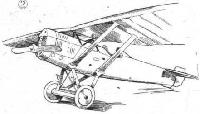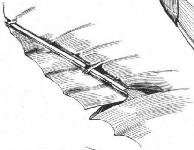
Flight, August 1923
GOTHENBURG International Aero Exhibition 1923
The Swedish Exhibit
<...>
If the single example of "Swedish" design and construction shown by the Naval Aircraft Works possessed but little interest, the same cannot be said of the three machines exhibited by Harens Flygvapens Flygverkstader of Malmslatt. If these machines still bear traces of German influence in design, they do, at least, indicate individual thought on the part of the designers, and an attempt has quite obviously been made to break away from the stereotyped, and to evolve new features. This applies particularly to the monoplane, the type J.23, which is a strut-braced parasol monoplane, possessing such modern features as streamline fuselage and thick wings tapered off to the tips and centre as in the latest British monoplanes, such as the Bristol and Hawker machines. It was difficult to determine with any degree of accuracy the wing section used, but at the point of greatest depth, i.e. where the bracing struts were attached, the section appeared to resemble one of the Gottingen, or Joukowsky, aerofoils.
A remarkable feature of the J.23, shared by the larger biplane, was the slotted ailerons, which, although possibly infringing the Handley Page patent, differed from the H.P. slotted ailerons as we know them by the fact that as the aileron was moved up or down the size of the slot did not change. While experiments in this country have shown the slotted ailerons to be very effective, it may be doubted whether the ailerons on the Swedish J.23 are of sufficient area. From one of the accompanying sketches it will be seen that the shape of the ailerons on the J.23 are of approximately triangular plan form, and as the length of each aileron cannot be much more than 3 ft. the area is quite small. Similar remarks apply to the rudder of almost all Swedish machines, which appear to be ridiculously small according to British standards. Reference was made in our Editorial Comments last week to this fact, and it was not surprising to learn, from one with practical experience of Swedish naval and military aviation, that spins frequently occur, and, unfortunately, often with serious results. While the small control surfaces may be, and probably are, sufficient at high speeds, it is inconceivable that they can have sufficient power at or near the stalling speed. Consequently it would seem probable that pilots are not able to make use of the lowest speeds at which the machines are capable of flying.
The fuselage of the J.23 is of elliptical cross section, and is constructed of three-ply panels over a light framework of stringers and formers. A specimen of such a fuselage was exhibited in the scientific section, and the workmanship of this was of a very high order of excellence.
No figures relating to wing area were available, but the following performance figures are of interest, and indicate that the machine must be of more than ordinary efficiency to attain the speeds claimed for it, bearing in mind that the engine is a B.M.W. rated at 185 h.p. only. This engine is of the high-compression type, and maintains its power up to considerable altitudes, but the performance, if really attained, is one nevertheless of which the designers have good cause to be proud.
The weight of the J.23 is 760 kg. (1,670 lbs.) empty and 980 kg. (2,160 lbs.) loaded. The speed at 1,000 m. (3,280 ft.) is stated to be 220 km. (136.4 m.p.h.), and at 3,000 m. (10,000 ft.) 250 km. (155 m.p.h.). The ceiling is given as 8,000 m. (26,300 ft.). The machine is armed with two synchronised machine guns, the sights for which are of very elementary type, placed on each side so that the pilot can sight from either side.
<...>
- Flight, August 1923
GOTHENBURG International Aero Exhibition 1923
Фотографии
-
Aviation Historian 32 / J.Forsgren - Sweden's parasol fighters
The J 23 protoype, serial 3111, just after its rollout from the FVM workshops at Malmslatt in the early summer of 1923. Note the vestigial rudder attached to the fuselage sternpost, later replaced with a larger conventional fin and rudder after trials revealed directional stability problems. The J 23’s BMW IIIa six-cylinder liquid-cooled powerplant was the German company’s first aero-engine
-
Air International 1985-09 / Fighter A to Z
The J 23 proved to possess too weak a structure and all examples of this type were rapidly withdrawn from service.
-
Aviation Historian 32 / J.Forsgren - Sweden's parasol fighters
The prototype J 23, by this time fitted with a revised larger fin and rudder, takes off for a test flight. The original rudder arrangement was described by Flight as “ridiculously small by British standards... while the small control surfaces may be, and probably are, sufficient at high speeds, it is inconceivable that they can have sufficient power at or near stalling speed”.
-
Aviation Historian 32 / J.Forsgren - Sweden's parasol fighters
Swedish test pilot Georg Gardin poses beside 3111 following his altitude record flight. Note the unusual slotted aileron of triangular planform on the port wing. British weekly Flight reported on the J 23 in August 1923 and explained that “as the aileron was moved up or down, the size of the slot did not change”, unlike Handley Page’s patented slotted aileron.
-
Aviation Historian 32 / J.Forsgren - Sweden's parasol fighters
The third production J 23 (fourth in total), serial 3117, is seen here with the “low-cut” fin and rudder, suggesting that this was fitted as standard on the production models for their entry into service. The BMW IIIa engine was of the high-compression type and was capable of maintaining power up to considerable altitude.
-
Aviation Historian 32 / J.Forsgren - Sweden's parasol fighters
With a further modified fin and rudder of lesser area than the prototype’s second configuration, the final production J 23, serial 3119, awaits a flight. The type’s fuselage was of elliptical cross-section, constructed of three-ply panels over a light framework of stringers and formers. The thick wings tapered both inboard and outboard.
-
Aviation Historian 32 / J.Forsgren - Sweden's parasol fighters
Lieutenant Wilhelm Nernst beside J 23 serial 3119. Tragically, having survived flying the notoriously tricky J 23, Nernst was killed in a mid-air collision over Simtuna in September 1924, while flying a Phonix D III. After Norberg’s death in 3111 in March 1924, the four remaining J 23s were grounded, so it is likely this photograph was taken in the second half of 1923.
-
Aviation Historian 32 / J.Forsgren - Sweden's parasol fighters
The J 24B dispensed with the parasol-wing configuration, the J 24’s damaged fuselage being repaired and used as the basis for a conventional biplane version. The latter was given the serial 5121 and, after flight testing, was handed over to test pilot Nils Soderberg as a personal hack, although it was overweight and little-used.
-
Aviation Historian 32 / J.Forsgren - Sweden's parasol fighters
The August 1923 Flight report also expressed reservations about the J 23’s handling characteristics, stating that a Swedish source had revealed that “spins frequently occur”. Within seven months the J 23 had claimed a pilot’s life, when Axel Norberg was killed in 3111 after a wing detached during an irregular spin.
-
Flight 1923-08 / Flight
AT GOTHENBURG: Some of the Swedish machines: The monoplane single-seater fighter, J.23, which has a 185 h.p. B.M.W. engine.
-
Flight 1923-08 / Flight
AT GOTHENBURG: Some Swedish constructional details. The very small slotted aileron of the J.23.
-
Air International 1985-09 / Fighter A to Z
The J 24B was essentially a J 23 rebuilt as a biplane and fitted with a more powerful engine, the sole example soon being written off.
- Фотографии












